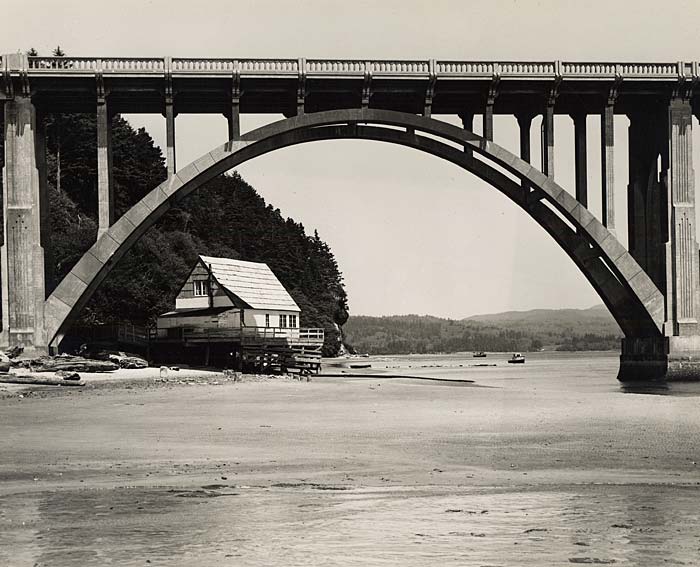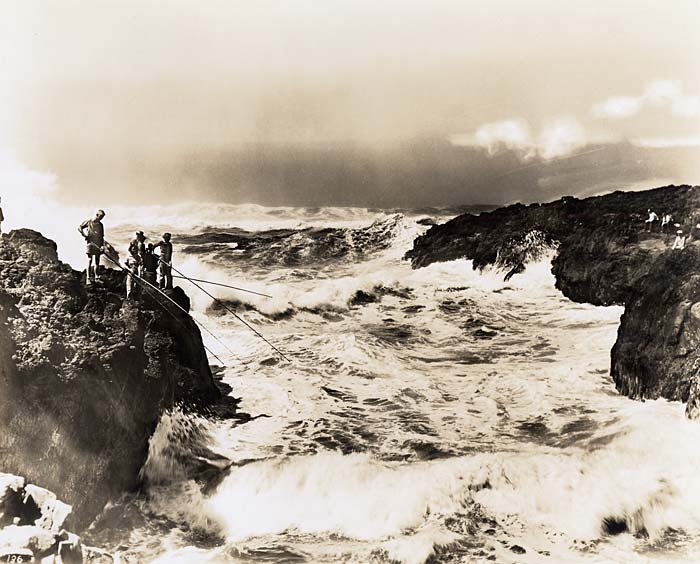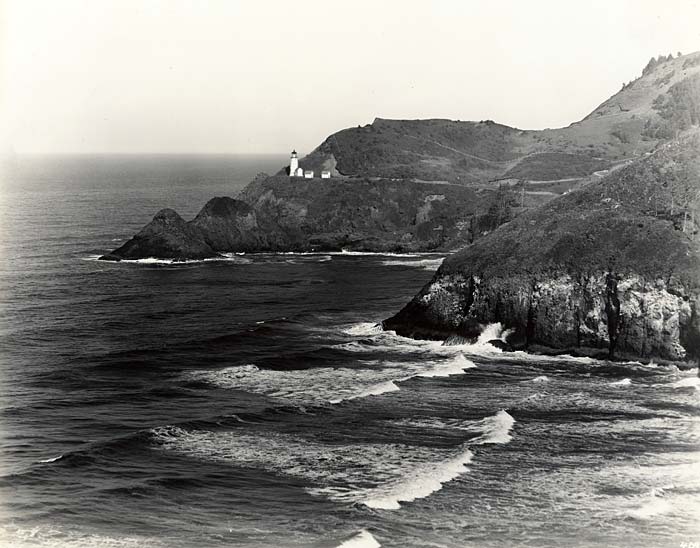This section of U.S. 101 even more closely hugs the sea than the section to the north. Villages are fewer because the Coast Range here presses closer to the sea.
 Seal Rocks (2413). Enlarge image.
Seal Rocks (2413). Enlarge image.
At the southern edge of NEWPORT, 0 m., the highway passes through a landscaped park, then crosses the YAQUINA BAY BRIDGE, 1 m., a graceful cantilever structure, completed in 1936. The bridge deck, rising to 138 feet above the channel water, is high enough to permit the passage of ocean-going craft. Yaquina Bay, cupped by green hills is L., and the bar and jetties, long fingers extending seaward from the promontories, are R. The north shore rises sheer 150 feet, but the south shore is low, with partly wooded dunes.
In the 1880s a townsite was platted at SEAL ROCKS, 10.5 m. A large hotel was built, but development lagged. Today the village consists of a store, a post office, and several cabin camps. Sea lions still bask on the rocks offshore.
Salal, huckleberry, and rhododendron grow luxuriantly in this region. Fir, pine, cedar, spruce, and hemlock trees appear brilliantly green in winter against dead fern, bare-limbed deciduous trees, and burned-over areas. The flowers of the rhododendron are reflected in small, brackish lakes in the hollows. The massed rhododendron blossoms are so striking that less showy blooms, such as heather, blue lupine, and scarlet paint brush, are often overlooked. Sand grasses, as well as the yellow sand verbena (whose roots were eaten by Indians), carpet the ground.
ALSEA BAY BRIDGE, 14.9 m., is another long cantilever structure, with three spans giving a clearance of 70 feet.
 Waldport, fisherman's house and arch of bridge (2505). Enlarge image.
Waldport, fisherman's house and arch of bridge (2505). Enlarge image.
The town of WALDPORT, 15.5 m. (20 alt., 367 pop.), (trips with fishing fleet arranged), on the south shore of the bay, was platted in 1884. Some inhabitants make a living by clam and crab fishing and packing, but summer visitors are an increasingly important source of income. Here are manufactured the brightly colored cedar floats that mark the crab fishermen's nets, which resemble huge butterfly nets, with steel rings at the top and sinkers at the lower end, where bait is fastened. These nets are used near the ocean shore and in bays, while copper or iron crab pots are employed farther out on the "banks." An annual Crab Festival is held here.
Waldport is at the junction with State 34.
U.S. 101 now parallels the beach, which was once the only road between Newport and Waldport.
On the wild beach meadow (R.) is an extensive grass-covered kitchen midden. Middens, found elsewhere along the Oregon Coast, are Indian trash piles, containing broken shells, fire-cracked rocks, bones, and plant matter. Similar shell mounds, considerably overgrown, are found elsewhere along the Oregon coast.
YACHATS (Ind., at the foot of the mountain), 24 m. (15 alt., 320 pop.), at the mouth of the Yachats River, is a popular resort with an excellent beach. Yachats Bay gravels yield agates, flowered jasper, blood stones, and petrified wood.
 Seawall south of Waldport (135). Enlarge image.
Seawall south of Waldport (135). Enlarge image.
The highway, here on a shelf of rock, widens in the seaward face of CAPE PERPETUA, to a masonry-guarded viewpoint at 26.2 m. For miles south of Yachats the Siuslaw National Forest extends to the rockbound coast, and trails and other recreational facilities have been developed. Near the cape a trail leads (R.) down to the DEVILS CHURN, a cavern that spouts water at intervals.
At 26.7 m. is the junction with an improved road.
Left to the top of CAPE PERPETUA, 2 m. (800 alt.), discovered by Captain Cook March 7, 1778, and so-named by him for St. Perpetua, the martyr put to death on that day in the year 203. On the promontory are an observation cabin and covered picnic cabins.
 Fishing at Devil's Churn south of Yachats (136). Enlarge image.
Fishing at Devil's Churn south of Yachats (136). Enlarge image.
Left from U.S. 101 on a second dirt road to the CAPE PERPETUA FOREST CAMP, 0.1 m.
SAND DUNE GARDENS, 35.6 m., sharply elevated on the east side, are exceptionally beautiful. The sand-laden wind trimmed the shrubs into remarkably similar patterns. Racks of brush along the highway protect it from the encroachment of sand. In the early days Chinese mined for gold in the area. Two dilapidated structures of their camp remain.
Rugged HECETA HEAD (520 alt.), 37.6 m., named for Bruno Heceta, the Spanish explorer who sailed near it in 1775, rises sheer above the ocean. HECETA HEAD LIGHTHOUSE, established in 1894, flashes powerful beams for the benefit of mariners.
DEVILS ELBOW TUNNEL, 38.1 m., at the southern end of CAPE CREEK BRIDGE, is a 680-foot bore through a jutting headland. It is in the 35-acre DEVILS ELBOW STATE PARK. The highway swings around a cliff, high above the ocean, affording a startling land and sea view.
The SEA LION CAVES (accessible by trail and stairway from highway; guide service included in adm. fee), 38.8 m., are ocean caverns inhabited during the winter by a herd of about 300 sea lions. The caves are at the base of a cliff around the curve below the tunnel. The herd is ruled by an old chieftain whose throne is the center rock in the main cavern, a chamber 1,500 feet long and colored green, pink, and pale yellow.
 Heceta Head Lighthouse from the highway (409). Enlarge image.
Heceta Head Lighthouse from the highway (409). Enlarge image.
The huge Steller (northern) sea lions are chestnut when young, tawny when old. These aquatic mammalian carnivora, which average 12 feet in length, are named for Georg Wilhelm Steller, a scientist who observed them during a 1741-42 Russian expedition headed by Vitus Bering.
During the summer, the sea lions live on the rocky islands off the coast of Alaska; they leave for the Oregon shore about September 1. When the herd reaches this place they mate and breed. Old and
skillful males will gather about them so numerous a "harem" that young bulls sometimes go for years without mates. Strangely, the pups protest vigorously against entering the water. The full-grown sea lion, if cornered, will attack a person and can cover the ground faster than a man can run. In May or early June, the herd leaves for Alaska.
The pigeon guillemot, a migratory bird that spends most of its life on the open sea, also comes here. The perpendicular cliffs at the entrance to the cove are the habitat of the tufted puffin, or sea parrot.
SUTTON LAKE (R.), 44.2 m., MERCER LAKE (L.), 44.8 m., and MUNSELL LAKE (R.), 47.4 m., are small duneland bodies of water among gray-trunked lodgepole pines. In June the pastel tints of rhododendrons brighten the dark recesses beneath the conifers.
At 49.9 m. is a junction with State 36.